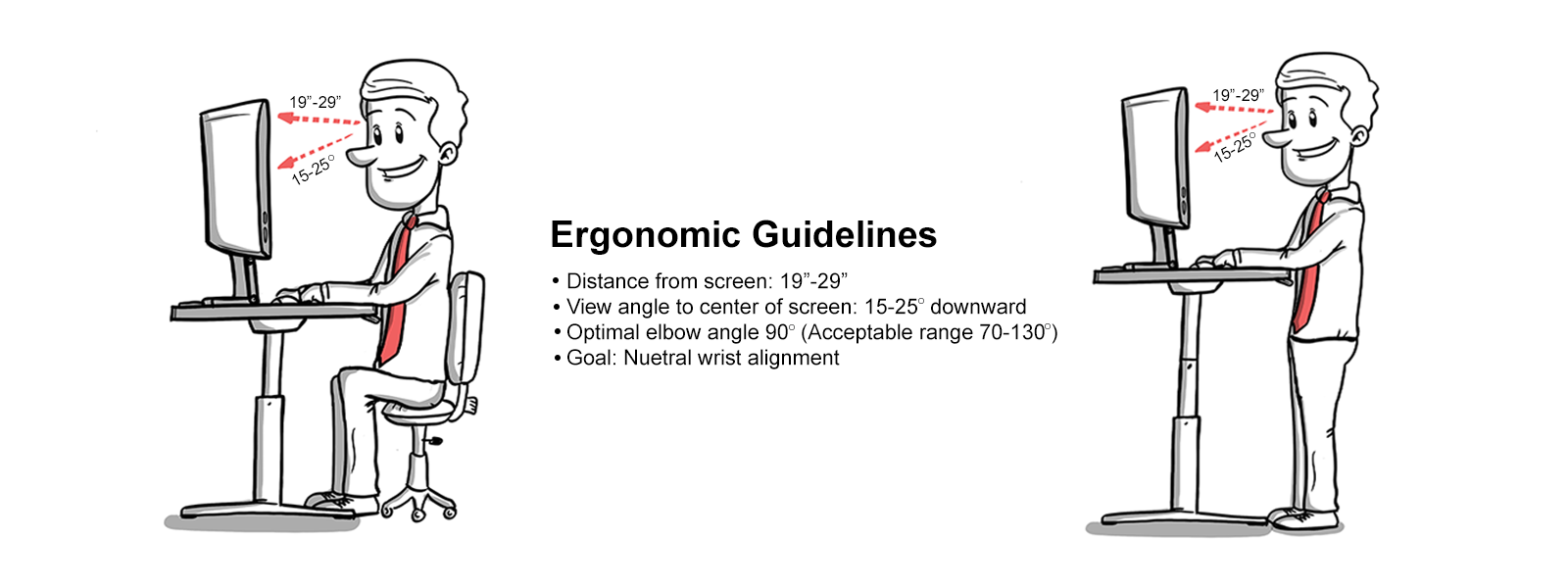Ergonomic Sit-To-Stand Desk
ERGONOMIC SIT-TO-STAND DESK
Which is better sitting or standing? The right answer is both. Because, even if your desk is set up properly, you can still get muscle fatigue from maintaining the same position for too long. They key is to keep moving. This is what ergonomists refer to as postural rotation.
Frequently changing positions promotes blood flow to the large muscle groups, which keeps your metabolism humming along and your brain synapses firing. The following video by Kinesiologist Stevyn Guinnip details the importance of both standing and sitting using an active chair such as the Varier MOVE available in our accessory store.
THE SCIENCE OF ERGONOMICS
MojoDesk is built to comply with ANSI-HFES 100-2007 National Ergonomic Standards.
An ergonomist studies ways to make our interactions with equipment as physically stress-free as possible. An ergonomically design workstation (a.k.a. your desk) helps increase energy levels and boosts productivity.
Adding mobility to the equation with a sit-to-stand desk can deliver additional health and productivity benefits, however, ergonomics should be a key factor in your decision on which sit-to-stand desk to purchase.
Five critical performance factors to consider when evaluating the ergonomics of a desk:
knee clearanceviewing anglesreach zonesfocal depthkeyboard surface height
BUY NOWI am concerned that the transition from sitting all day to standing all day will not work for me. Do you have suggestions for a gradual transition?
Standing all day has as many negative aspects as does sitting. Mojo Desk is a true sit to stand desk which is designed to properly accommodate a wide range of different size people – from the 5th percentile seated female to the 95th percentile standing male user.
Our recommendation is to gradually ease into working in a standing position by starting out in a standing position and changing to sitting whenever you become even slightly uncomfortable standing. Depending on many factors such as fitness level, age, medical issues, etc. you could gradually move into working in a standing position more than 50% of the time. The key is MOVEMENT – postural rotation between seated and standing.
I am considering the purchase of a “desk converter” to change my existing desk into a standing desk. What do I need to know?
First, measure the distance from the floor to the top of your existing desk. If it is greater than 28” adding a converter will turn it into a stand only desk unless you are 6’3” or taller. Fixed height desks are designed to fit the 95th percentile seated male user, so putting a converter on top of it will render it a poor ergonomic solution for seated work. Consider a true sit to stand desk with an adjustment range of 24” – 50” so you can get the benefits associated with MOVEMENT regardless of your size.
You talk about “built to commercial standards” specifically referencing BIFMA, what is that all about?
BIFMA stands for the Business and Institutional Furniture Manufacturers Association – an office furniture trade industry association comprised of the large (Billion$+) office furniture manufacturers and many smaller organizations as well.
Manufacturers volunteer engineers for specific committees, and they jointly develop test procedures that measure structural integrity and durability regardless of the joinery or assembly or materials used in construction. Mojo Desks are designed, manufactured and tested to BIFMA standards by independent test labs.
We not only claim compliance – we prove it!!
You stress safety and I agree! Could you explain why Mojo Desk’s collision detection is better than the others?
Mojo Desk uses an extra cost accelerometer to precisely monitor any minute change in the orientation or velocity of the top and stops immediately upon encountering any obstruction. Mojo Desk’s collision detection works equally well in either up or down direction.
The standard collision detection that comes with other tables will not react to a collision with something soft – like your leg or a chair – and easily tip the table and its contents onto the floor.
I NOTICE THAT YOU DON’T OFFER A KEYBOARD PLATFORM – WHY?
Most keyboard platforms are small and wobbly. They need to be adjusted manually by the user and generally are seldom used once the “newness” wears off. The reason for keyboard platforms was to achieve neutral wrist alignment which can be achieved through proper height adjustment of your MojoDesk.
YOU SELL AN ANTI-FATIGUE MAT. WHAT ARE THE BENEFITS?
Mojo Desk is a sit to stand desk with an adjustment range of 24” – 50”. It is intended to promote postural rotation - the change from seated to standing work. When you feel even the slightest discomfort while standing hit your preset memory button and your Mojo Desk will automatically stop at your personal optimal seated posture. We recommend a minimum change rate of at least once per hour with no specific time working in either position.
With that said, adding a standing desk mat keeps your feet and body comfortable while you stand. This is especially helpful if you are rocking high heels or some slick looking dress shoes that are made more for looks than comfort. But a standing marathon is not advised; always change positions. You can learn more and purchase our Mojo Comfort Mat HERE.




